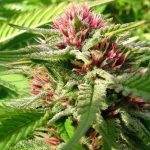U.S. Attorney Bob Troyer, U.S. Forest Service Special Agent in Charge Kent Delbon, and Bureau of Land Management (BLM) Special Agent in Charge Gary Mannino announced all three agencies are working together with local law enforcement to make public lands safer, to prevent environmental damage, and to combat illegal marijuana trafficking. U.S. Immigration and Customs Enforcement’s (ICE) Homeland Security Investigations (HSI) provided substantial assistance.
During 2017, Forest Service agents and BLM officers, in concert with local law enforcement, dismantled marijuana operations on public land throughout the state, with several defendants receiving sentences of up to five years in federal prison. In Colorado, the marijuana growing season typically runs from early summer through the fall, which is when the cases listed below were brought last year:
- United States v. Santos Ramirez-Alvarez and Santos Ramirez-Carrillo, Case No. 17-cr-338: On two islands in the Colorado River near DeBeque, Colorado, about 9,100 marijuana plants were found growing on BLM land. Water from the Colorado river was diverted to irrigate the grow, while money derived from the grow went to individuals in Sinaloa, Mexico. Two defendants were arrested, charged, and pleaded guilty to a conspiracy to manufacture and distribute marijuana. They were sentenced to 57 months and 60 months in prison, respectively.
- United States v. Fernando Esquivel Herrera, No. 17-cr-402: In the White River National Forest, near Placita, Colorado, about 2,700 marijuana plants were found growing on about 8 acres of public land, with another 3,000 plants already harvested. Multiple bottles of WD-40 were found at the site. The defendant was charged with conspiracy to manufacture and distribute marijuana plants, along with other crimes. He was sentenced to 60 months in prison.
- United States v. Neil Andrew McKay, No. 17-cr-403: On BLM land near Whitewater, Colorado, about 100 marijuana plants were located. The defendant – who was homeless – was found with a loaded handgun in his possession. He was sentenced to 12 months and 1 day in prison.
- United States v. Vincente Medrano Duque, No. 17-cr-320: In the San Isabel National Forest near Rye, Colorado, about 7,500 plants were located on a grow affecting about four acres. The defendant was charged and pleaded guilty to conspiracy and possession with intent to distribute marijuana plants, land depredation, and illegal re-entry after deportation. Sentencing is scheduled for the end of August.
- United States v. Danilo Jemenez-Lopez and Margarito Yepez-Sanchez., No. 17-cr-372: In the San Isabel National Forest near Rye, Colorado, about 14,000 marijuana plants were located on a grow affecting about 12 acres. Two defendants were charged, and one pleaded guilty to conspiracy to manufacture, distribute, and possess marijuana, as well as land depredation. The case against defendant Jemenez-Lopez is still pending.
- United States v. Cutberto Reyes-Martinez, Gildardo Mendez-Arizmendi, Martin Sandoval-Arizmendi, and Pedro Fernando Segovia Rosales., No. 17-cr-375: In the San Isabel National Forest near Salida, Colorado, about 4,000 marijuana plants were located on a grow affecting about seven acres. Four defendants were charged and pleaded guilty to conspiracy and possession with intent to distribute marijuana plants. Two defendants were also charged and pleaded guilty to illegal re-entry after deportation. The defendants were sentenced individually to 20, 24, 60 and 24 months in prison.
- United States v. Virgilio Alain Reyes Cervantes and Erik Pimental Magana Plata, No. 17-cr-431: In the San Isabel National Forest near Rye, Colorado, about 9,000 marijuana plants were found on a grow affecting about seven acres. Two defendants were charged with conspiracy and possession with intent to distribute marijuana. They were sentenced to 15 and 21 months in prison, respectively.
In addition to the U.S. Forest Service and the Bureau of Land Management, Homeland Security Investigations assisted with a number of the investigations mentioned above.
More than 71,000 marijuana plants were removed from about 38 acres of Colorado public lands (not including the islands on the Colorado river) during last year’s growing season. The environmental impact was significant. From marijuana grows in the San Isabel National Forest, for example, the Forest Service estimates that about 5,000 pounds of trash and infrastructure were found at each grow site. Man-made reservoirs and numerous structures were built from cut pine timber. Pesticides and other chemicals were also found and removed. It took hundreds of hours to clean up each site to mitigate the environmental harm to the public lands.
“Public lands are just that – they’re public and belong to all of us,” said U.S. Attorney Troyer. “These black marketers abuse our land, our water, our animals and plants. With these prosecutions we motivate black marketers to make less harmful occupational choices.”
“We appreciate the continued support and commitment from the US Attorney’s Office working with the USDA Forest Service along with our state and local partners to dismantle and disrupt illegal marijuana cultivation on public lands,” said Forest Service Special Agent in Charge Kent Delbon. “The continued success of these eradications and prosecutions protects forest visitors, employees, nature, and wildlife from the harmful effects of illegal marijuana cultivation on national forests.”
“Illegal marijuana grows on public lands pose safety and environmental risks to all of us,” said Gary Mannino, BLM Colorado Special Agent in Charge. “We will continue to work with local, state and federal agencies to ensure that the public is safe when they recreate on their lands, and that we protect the natural resources in our care.”
These cases are handled by Assistant U.S. Attorneys who specialize in prosecuting those responsible for illegally growing marijuana, polluting our public lands and selling the marijuana to the black market.
(345)





Leave A Reply